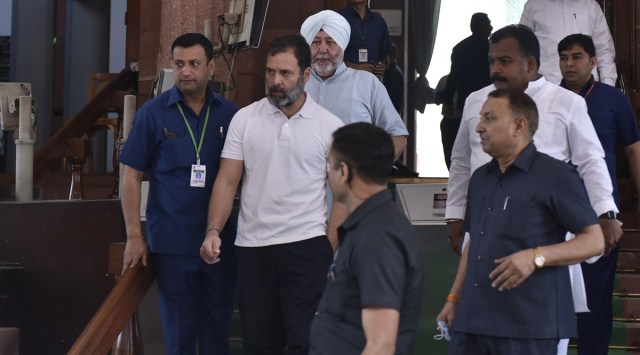
Written by Siddharth Luthra
As law students, we were taught that hard cases lead to development of the law and when they relate to public figures, it is more so the case. The recent conviction and two-year sentence of Rahul Gandhi has thrown up a host of legal issues and concerns regarding the harshness of the criminal defamation law as also, the disqualification of MPs/MLAs on conviction, with a sentence of two years.
While there are loud voices contending that criminal defamation is an anachronism, and doubt its legitimacy, the fact is that the Supreme Court had, in Subramaniam Swamy (2016) upheld the constitutional validity of Sections 499/500 IPC (criminal defamation). Incidentally, in that set of cases, Rahul Gandhi was a party.
Another concern is of the nature of sentence imposed — the maximum of two years — which is unprecedented, if not unusual. But these are matters best left for his lawyers to agitate in court.
In the past, others such as Lalu Prasad, have met a similar fate of being disqualified on conviction. With Rahul Gandhi’s disqualification, there is again a public debate on the “supposed” harshness of the consequences of disqualification on conviction, and the purported haste in issuing the notification, amongst other issues.
As decided by the Supreme Court in Manoj Narula (2014) , the sentence being two years in this case, there is a six-year disqualification, post release from custody [under Sc. 8 (3) of Representation of Peoples Act, 1951 (1951 law)]. What is not being considered by those protesting is that the Constitution under Article 102 and 191 specifically provides for the effect of a disqualification, that is, the seat falls vacant immediately on conviction and sentence. Post the notification by the Speaker, the Election Commission can begin the process of a by-poll, leading to an irreversible situation for the public figure.
Though the issue of disqualification has caught the eye of the Courts since the 1951 law was enacted, till 2013, Section 8 (4) of the 1951 law gave a convicted (and disqualified legislator) a window of three months to approach the Appellate Court. During this window of three months, the disqualification would not take effect.
But this provision was struck down in Lily Thomas (2013) by the Supreme Court. The effect of Lily Thomas was to clarify that in the Constitution, the disqualification takes effect at the time of conviction and sentence. The Ordinance that was sought to be brought in by the UPA government immediately to overcome the Lily Thomas decision did not go through either.
Having argued and lost the Lily Thomas case for the Union, on revisiting that judgment, I find, that while it struck down Section 8 (4) of the 1951 law, it reiterated the ambiguity [following Ravikant S Patil (2007)] as to the effect of a stay of conviction after the disqualification has occurred on conviction and sentence.
In 2018, the Supreme Court in the Lok Prahari case recorded that such a stay of conviction “would relieve the individual from suffering the consequence of a disqualification relatable under Section 8 of the Act”. Ironically, it relied on Lily Thomas, which had earlier said that the seat automatically falls vacant.
In the absence of the struck-down three-month window, the issue will be whether the clock can be turned back for a disqualified legislator if a stay of conviction is granted subsequently.
Post disqualification on conviction, the notification of the Speaker (for Lok Sabha) is a formal act as the disqualification has already taken place and the time of issuing it is of little consequence unless it is inordinately withheld. Such a disqualification enables the Election Commission to initiate the process of a by-poll for the seat that has fallen vacant. And once the by-poll process begins, the individual granted a stay of conviction from the higher courts can go back to the Speaker to undo the disqualification.
What must not be lost sight of is that an order granting a stay of conviction is resorted to in rare cases depending on facts and a stay of a conviction renders a conviction non-operative but not non-existent.
In Ravikant S Patil (2007), the Supreme Court highlighted that “only in exceptional cases” the court should exercise powers to stay a conviction. In that case, the stay of conviction enabled an individual’s nomination to stand, and that principle has been followed by the Supreme Court in 2013 and 2018.
The way forward for a convicted (and disqualified) individual such as Rahul Gandhi, is to file an appeal and seek a stay of conviction (rare though it may be) pointing out the legal infirmities, if any, and the grave consequences including disqualification, and then if a stay is indeed granted, to approach the Speaker to undo the disqualification — hoping (and praying), that in the meantime, the by-election is not announced. If it is not announced, yet the Speaker does not accept the plea that the stay of conviction stops the effect of the disqualification, the remedy would be to approach the courts.
It is needless to say, even if the by-poll is announced, the stay of conviction would enable the disqualified individual to contest the by-poll.
Hopefully, once and for all, the last mile of legal interpretation of the disqualification provisions will be covered by the constitutional courts. This is an issue which remains open even after 70 years after the 1951 disqualification law came into existence.
The writer is a Senior Advocate and former Additional Solicitor General of India